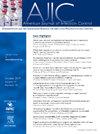Factors associated with correction of personal protective equipment nonadherence in a multidisciplinary emergency department setting: A retrospective video review
IF 3.8
3区 医学
Q2 INFECTIOUS DISEASES
引用次数: 0
Abstract
Background
Despite local and national recommendations, health care provider adherence to personal protective equipment (PPE) varied during the COVID-19 pandemic. Previous studies have identified factors influencing initial PPE adherence but did not address factors influencing behaviors leading to correction after initial nonadherence.
Methods
We conducted a retrospective video review of 18 pediatric resuscitations involving aerosol-generating procedures from March 2020 to December 2022 to identify factors associated with nonadherence correction. We quantified adherent and nonadherent providers, instances of PPE nonadherence, and time to correction. We also analyzed correction behaviors, including provider actions and correction locations.
Results
Among 434 providers, 362 (83%) were nonadherent with at least 1 PPE. Only 186 of 1,832 instances of nonadherence were corrected, primarily upon room entry and during patient care. Correction time varied by PPE type and nonadherence level (incomplete vs absent). Most corrections were self-initiated, with few reminders from other providers.
Discussion
Potential barriers to correction include a lack of social pressure and external reminders. Solutions include optimizing PPE availability, providing real-time feedback, and educating on double gloving.
Conclusions
Most providers were nonadherent to PPE requirements during high-risk infection transmission events. The low correction rate suggests challenges in promoting collective responsibility and maintaining protective behaviors during medical emergencies.
在多学科急诊科环境中纠正不遵守个人防护装备规定的相关因素:回顾性视频回顾。
背景:尽管地方和国家都提出了建议,但在 COVID-19 大流行期间,医疗服务提供者对个人防护设备 (PPE) 的依从性各不相同。以前的研究确定了影响最初坚持使用个人防护设备的因素,但没有涉及影响最初不坚持使用后改正行为的因素:我们对 2020 年 3 月至 2022 年 12 月期间涉及气溶胶产生程序 (AGP) 的 18 例儿科复苏进行了回顾性视频审查,以确定与纠正不依从性相关的因素。我们对坚持和不坚持的提供者、不坚持使用个人防护设备的情况以及纠正时间进行了量化。我们还分析了纠正行为,包括医疗服务提供者的行动和纠正地点:在 434 名医疗服务提供者中,有 362 人(83%)不遵守至少一项 PPE。在 1,832 次不遵守行为中,只有 186 次得到了纠正,主要是在进入病房和护理病人期间。纠正时间因个人防护设备类型和不遵守级别(不完全遵守与未遵守)而异。大多数纠正都是自己主动进行的,很少有来自其他医疗服务提供者的提醒:讨论:纠正的潜在障碍包括缺乏社会压力和外部提醒。解决方案包括优化个人防护设备的可用性、提供实时反馈以及开展双层手套教育:大多数医疗服务提供者在高危感染传播事件中未遵守个人防护设备要求。低纠正率表明,在医疗紧急情况下促进集体责任和保持防护行为面临挑战。
本文章由计算机程序翻译,如有差异,请以英文原文为准。
求助全文
约1分钟内获得全文
求助全文
来源期刊
CiteScore
7.40
自引率
4.10%
发文量
479
审稿时长
24 days
期刊介绍:
AJIC covers key topics and issues in infection control and epidemiology. Infection control professionals, including physicians, nurses, and epidemiologists, rely on AJIC for peer-reviewed articles covering clinical topics as well as original research. As the official publication of the Association for Professionals in Infection Control and Epidemiology (APIC)

 求助内容:
求助内容: 应助结果提醒方式:
应助结果提醒方式:


